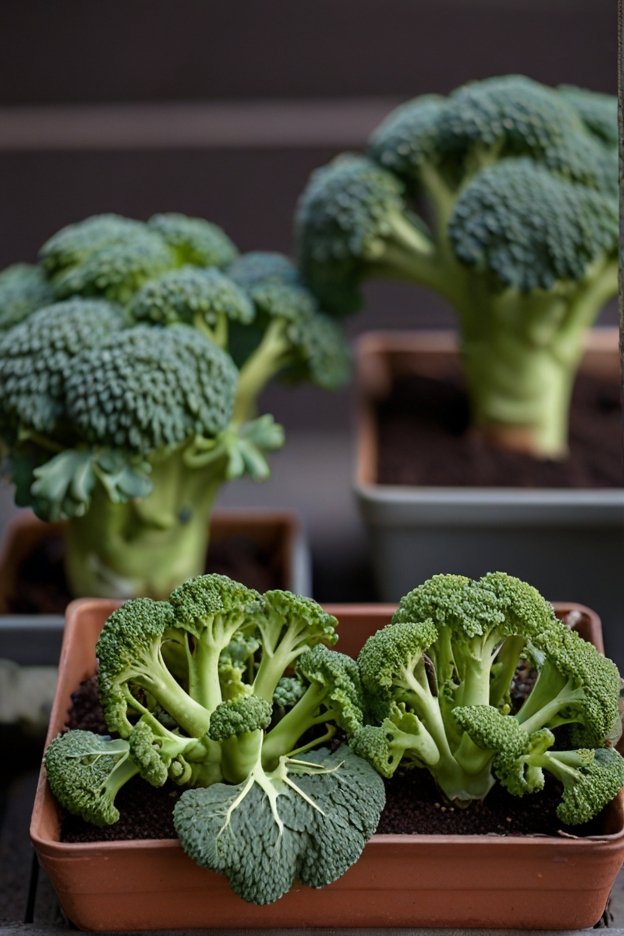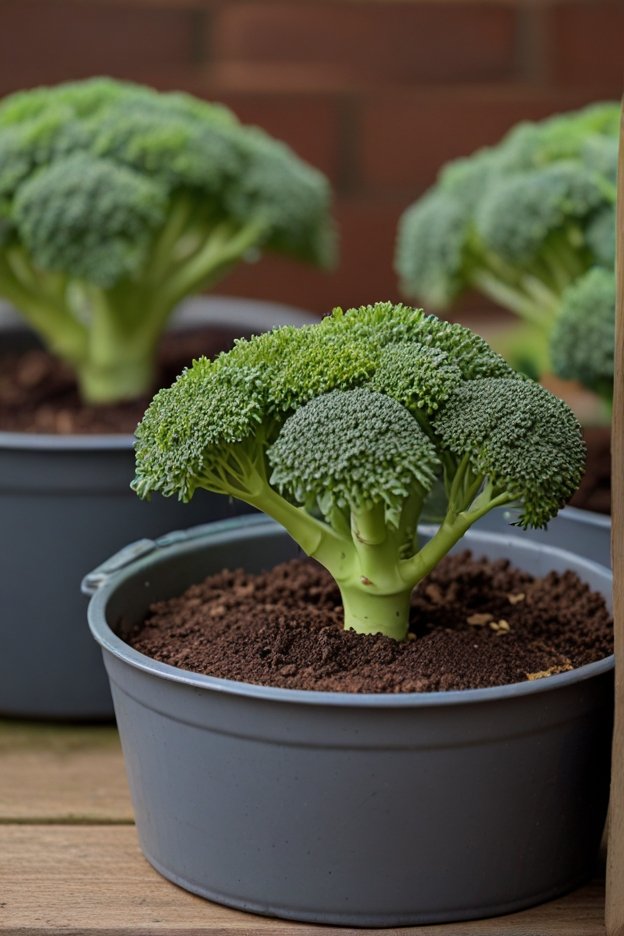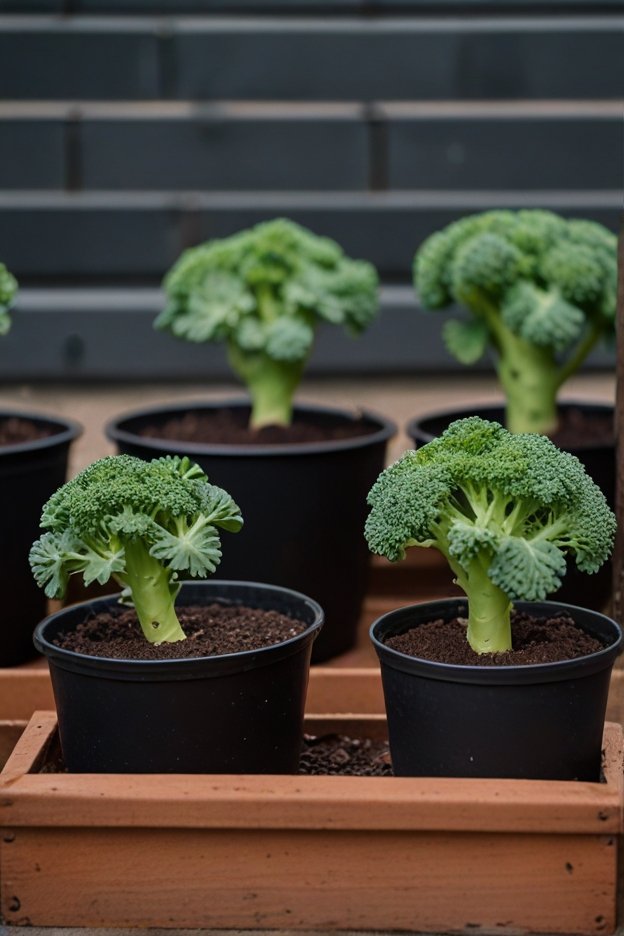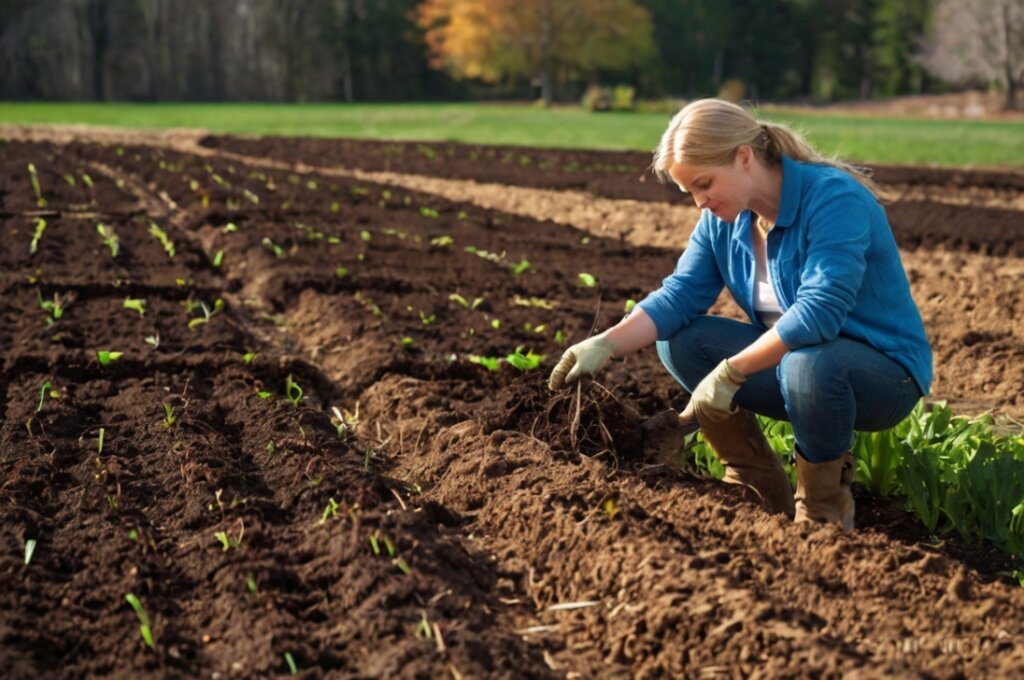
Growing broccoli in containers is a fun and rewarding experience for gardeners with limited space.
In this article, we will explore the best practices for growing broccoli in containers, including choosing the right container, selecting the right variety, planting and caring for your plants, and harvesting your delicious broccoli crowns.
Choosing the Right Container
When choosing the right container for your plants, several factors come into play to ensure their optimal growth and health:
Size requirements
The size of the container is crucial for accommodating the root system and promoting healthy plant development.
Aim for a container that is at least 12 inches deep and wide for a single plant.
If you’re planning to grow multiple plants in one container, opt for a larger size to provide ample space for each plant’s roots to spread out comfortably.
Insufficient space can restrict root growth and lead to stunted growth or root-bound plants.
Material
The material of the container plays a significant role in maintaining proper moisture levels and preventing waterlogging and root rot.
Choose containers made of breathable and well-draining materials such as clay, plastic, or fabric.
Clay pots offer good airflow and moisture regulation but may dry out more quickly.
Plastic containers are lightweight and retain moisture well, making them suitable for a wide range of plants.
Drainage holes
Adequate drainage is essential to prevent water from accumulating at the bottom of the container, which can lead to waterlogging and root suffocation.
Ensure your chosen container has sufficient drainage holes at the bottom to allow excess water to escape freely.
If the container lacks drainage holes, consider drilling or creating additional openings to facilitate proper drainage and prevent water-related issues.

Selecting Your Broccoli Variety
When it comes to selecting the right broccoli variety for your container garden, consider the following options:
Different broccoli varieties
Broccoli comes in various varieties, each with its unique characteristics and growing requirements.
Two popular options are Calabrese and Arcadia.
Calabrese broccoli is known for its rapid growth and abundant production of large, domed heads.
It’s well-suited for container growing, especially in smaller spaces where vertical growth may be limited.
Arcadia broccoli, on the other hand, is prized for its disease resistance and reliability.
It produces slightly smaller heads than Calabrese but offers excellent flavor and texture.
Faster-maturing, compact varieties
When choosing broccoli varieties for container gardening, prioritize faster-maturing and compact options that can thrive in limited spaces.
These varieties typically reach maturity quicker than traditional broccoli types, making them ideal for container cultivation, where space may be at a premium.
Faster-maturing varieties allow you to enjoy homegrown broccoli sooner and maximize the productivity of your container garden.
Planting Your Broccoli Seeds
When it comes to planting broccoli seeds for your container garden, here’s a step-by-step guide to ensure successful growth:
Timing
Consider your local climate and the specific requirements of broccoli plants.
In cooler regions, it’s best to plant broccoli seeds indoors before the last frost date.
This allows the seedlings to establish and grow before being exposed to outdoor conditions.
Starting indoors (optional)
To give your broccoli seeds a head start, consider starting them indoors in seed trays filled with high-quality potting mix.
This method provides optimal conditions for germination and early growth, allowing you to control factors such as temperature, humidity, and moisture levels.
Transplanting seedlings
Once your broccoli seedlings have developed sturdy stems and several sets of true leaves, it’s time to transplant them outdoors.
Before moving them directly into your container garden, it’s crucial to harden off the seedlings.
This involves gradually exposing them to outdoor conditions, such as sunlight, wind, and fluctuating temperatures, over a period of several days.
Planting seeds directly
In warmer climates, you have the option to plant broccoli seeds directly in your container garden.
Choose a location with ample sunlight and prepare the soil by loosening it and removing any debris.
Plant the seeds at the recommended depth, typically around 1/4 to 1/2 inch deep, and cover them lightly with soil.
Keep the soil consistently moist but not waterlogged until germination occurs.

Setting Up Your Broccoli Haven
When setting up your broccoli container garden, attention to detail can make all the difference in ensuring your plants thrive.
Here’s how to create the perfect environment for your broccoli:
Location
Selecting the right location is crucial for the success of your broccoli plants.
Choose a spot that receives ample sunlight, ideally 6-8 hours of direct sunlight each day.
Broccoli is a sun-loving plant and requires sufficient sunlight to grow and develop healthy heads.
Avoid areas that are shaded or receive minimal sunlight, as this can result in leggy growth and poor harvests.
Potting mix
The choice of potting mix plays a significant role in providing the essential nutrients and optimal growing conditions for your broccoli.
Opt for a well-draining organic potting mix that is rich in nutrients.
A good-quality potting mix ensures proper aeration, moisture retention, and root development, promoting healthy growth and robust broccoli plants.
Avoid using heavy or compacted soils that may impede drainage and lead to waterlogging, which can cause root rot and other issues.
Caring for Your Container Broccoli
Caring for your container-grown broccoli is essential to ensure it thrives and produces a bountiful harvest.
Here are some key care tips to keep your broccoli plants healthy and productive:
Watering
Proper watering is crucial for the health of your broccoli plants. Water deeply and evenly, ensuring that the soil is consistently moist but not waterlogged.
Aim to water the plants at the base to prevent wetting the foliage, which can increase the risk of fungal diseases.
Allow the top inch of soil to dry out between waterings to prevent waterlogging and root rot.
Mulching
Mulching is an excellent practice to conserve moisture, suppress weeds, and maintain soil temperature in your container garden.
Apply a layer of organic mulch, such as straw, shredded leaves, or compost, around the base of your broccoli plants.
This helps retain moisture in the soil, reducing the frequency of watering and promoting healthy root development.
Feeding
Providing your broccoli plants with adequate nutrients is essential for their growth and productivity.
Use a balanced fertilizer formulated for vegetables and apply it every few weeks during the growing season.
Follow the manufacturer’s instructions for application rates and timing.
Alternatively, you can use organic fertilizers such as compost or well-aged manure to enrich the soil and provide essential nutrients to your broccoli plants.

Harvesting Your Broccoli Crowns
Harvesting your broccoli crowns is an exciting culmination of your efforts in caring for your plants.
Here’s a detailed guide on how to harvest your broccoli and troubleshoot common problems:
Signs of maturity
To determine if your broccoli is ready for harvest, look for a firm, compact head with tightly closed florets.
Avoid waiting too long to harvest, as over-mature broccoli can become tough and bitter.
Cutting techniques
When harvesting your broccoli, use sharp tools such as garden shears or a knife.
Cut the stalk just below the head in a swift motion to ensure a clean cut and minimize damage to the plant.
Cutting at an angle can help water drain away from the cut surface and prevent disease transmission.
Encouraging secondary shoots
After harvesting the main head, continue to monitor your broccoli plants for the emergence of side shoots.
These secondary shoots will develop into smaller broccoli heads, providing you with multiple harvests from a single plant.
By removing the main head promptly, you encourage the plant to divert energy into producing these secondary shoots.
Troubleshooting Common Problems
Identify and address common pests
Keep a close eye on your broccoli plants for signs of common pests such as aphids or cabbage worms.
If you notice any pests, take immediate action to address them using organic pest control methods like insecticidal soap or neem oil.
Regularly inspecting your plants allows you to detect pest infestations early and prevent them from causing significant damage.
Address diseases
Proper disease management is crucial for maintaining the health of your broccoli plants.
Ensure good air circulation around your plants and avoid overhead watering to minimize the risk of fungal diseases like powdery mildew.
If you notice any signs of disease, such as discolored or distorted foliage, promptly treat your plants with natural fungicides like neem oil or copper spray to prevent the spread of disease and protect your crop.

Conclusion
Growing broccoli in containers is a delightful venture for those with limited gardening space.
These guidelines ensure a fruitful harvest right in your backyard.
Container gardening offers a fantastic opportunity to cultivate broccoli even with limited space.
These tips ensure a successful harvest in your own backyard.
FAQs
Select well-draining pots made of clay, plastic, or fabric to prevent waterlogging and root rot.
Use insecticidal soap, neem oil, or diatomaceous earth to control pests without harming beneficial insects.
Maintain proper air circulation and use natural fungicides like neem oil or copper spray to prevent diseases like powdery mildew.
Use seed trays with good quality potting mix and follow the instructions on the seed packet.



